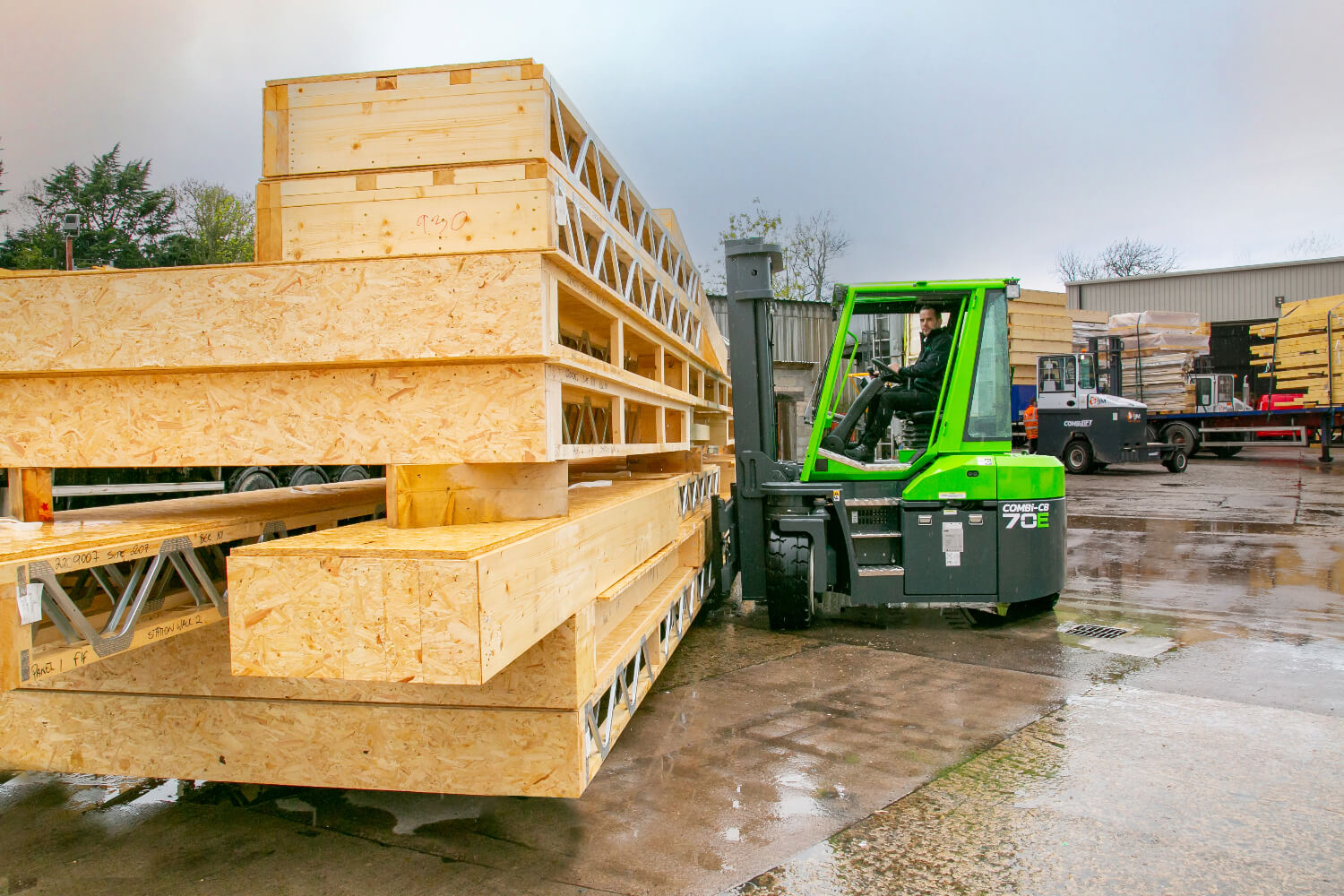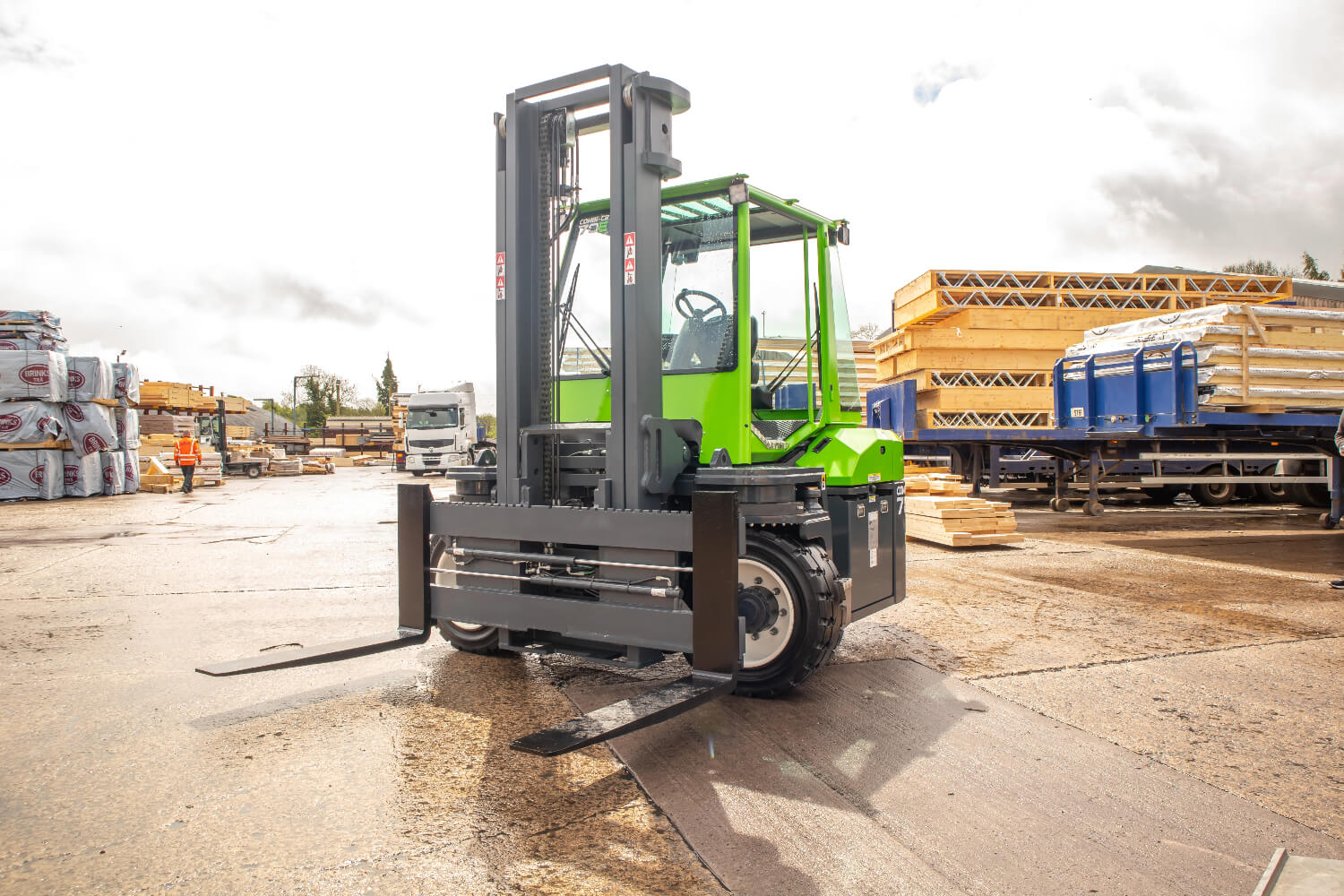
This piece was written and provided by FTMA Supporting Partner, Combilift.
How Combilift’s latest electric innovation – the Combi-CB70E – is taking both operational efficiency and operator comfort to the next level.
Since developing the world’s first engine-powered multidirectional forklift – the C4000 – Irish manufacturer Combilift has not taken its foot off the innovation pedal. And having recently celebrated its quarter-century anniversary in 2023, the company marked the occasion with the debut of several exciting new products.
One such product, the Combi-CB70E, is the latest addition to Combilift’s range of electric machines. Launched alongside a handful of new models, including the Combi-CUBE, as part of the manufacturer’s 25-year celebrations, the bright green multi-directional forklift is a testament to Combilift’s commitment to innovation.
Colin Gray, Combilft’s Regional Manager for Norway and Finland, says the CB70E combines both well-established and newly developed features to set a new bar for lifting efficiency – even in tough conditions.
“We see a lot of applications such as sawmills where the yards aren’t paved, so operators are often dealing with rough surfaces and potholes,” he says. “With the CB70E’s extra-large wheels, we see applications like these as a huge potential market for us. That’s a big reason we launched the machine at the Ligna international timber and woodworking show in May 2023 – and we’ve had a lot of interest in it since then.”

Compact power
Combining a 7,000kg lift capacity with a small footprint and excellent manoeuvrability, the CB70E has been designed to enable operators to move bulky loads more easily in tighter areas.
“Typically, counterbalanced forklifts will measure 3.5m from the face of the fork the back of the machine,” Colin says. “So, operators will need a certain amount of clearance if they’re turning into an aisle with a load of timber. With the CB70E, that measurement is 2.68m – almost a metre smaller.”
Combined with the CB70E’s multidirectional design, Colin says, the manoeuvrability benefits are essentially doubled.
“We see this as a huge benefit in both timber and steel applications,” he says. “For anybody handling awkward loads of seven tonnes or more, manoeuvrability is key.”
Another stand-out feature of the CB70E is its Red Dot Award-winning independent traction system, which eliminates the need for differential lock on slippery surfaces and reduces long load momentum twisting when travelling laterally.
“Depending on the steering angle, this system is programmed to ensure every wheel is always rotating at the correct speed,” Colin says. “This results in reduced tyre wear, as well as better traction in rougher terrain.”

Elevating ergonomics
Given many industries are still wrestling with skilled labour shortages, operator comfort has become a point of renewed focus for many equipment manufacturers. With operators spending such long hours in their machines, the ergonomic design of cabins and controls are essential to minimise physical strain and fatigue – a benefit to both productivity and site safety.
“In the past, operators might have commented that our forklifts didn’t have the same comfort features as some of our competitors,” Colin says. “But with its bigger wheels and comfortable cab, we see the CB70E as fully comparable with any other counterbalanced forklift in the market in terms of ergonomics.”
What separates the CB70E from the forklift pack is its gas strut suspension cabin, which uses components often found in larger-scale industrial machinery. Combined with Combilift’s super-elastic tyres, operators can be ensured a smoother experience, even on rougher surfaces.
Another newly developed feature, the CB70E’s Auto Swivel Seat, automatically swivels 15 degrees to the left or right, depending on travel direction. This helps both maximise visibility for the operator, and reduces physical strain when reversing.
According to Mark Whyte, Research and Development Manager – and Combilift’s first ever employee – this innovation came to him and his team while travelling on a business trip.
“We were travelling back home and discussing ways we could improve safety and comfort for operators,” he says. “And we came up with this idea whereby the seat would rotate automatically according to the direction of travel, taking the strain off the operator’s body and neck.”
Mark says the Combilift team’s freedom to innovate stems in part from its deeply ingrained positive company culture – one that has seen many key personnel stay with the company for multiple decades.
“There’s a group of people that have been here for the full 25 years, and quite a lot that have ticked over 20 and 15 years,” he says. “All those people have grown with the company, and have helped maintain a culture where everyone comes together with their ideas. It makes for a very ‘can-do’ attitude throughout the company – from the upper management all the way down.”

Electric future
The vibrant green colour scheme of the CB70E is not just a safety feature – it’s indicative of Combilift’s focus on developing more environmentally friendly options for the industries it serves.
In fact, more than 70 per cent of Combilift’s in-production vehicles are now electric. And, according to CEO and Co-founder Martin McVicar, electric equipment is now the focus of about 98 per cent of the company’s research and development (R&D) resources.
“As a company, we’re inherently focussed on sustainable solutions,” he says. “We’re focussed on making vehicles that are more environmentally friendly to use, as well as vehicles that enable our customers to make their warehouse utilisation more environmentally friendly.
“The increased capacities that we are offering in our electric range will answer the demand for ever more powerful products, while at the same time helping companies to achieve their aims for more sustainable operations.”
It’s this commitment to minimising environmental impact that has driven Combilift’s use of lead-acid instead of lithium batteries – a decision that might seem at odds with the industry at large.
But it’s for one very good reason: recyclability. According to CSIRO, lithium waste remains a problem without a solution – only 10 per cent of Australia’s lithium-ion battery waste was recycled in 2021, as opposed to 99 percent of the lead acid equivalent.
“We’re going to continue to grow our business organically with a key focus on R&D and building products that adhere to our three pillars: improving safety, maximising storage, and increasing efficiency,” Martin says.
It’s a sentiment shared by Mark, who adds that keeping in touch with the needs of the end user is paramount.
“We listen to our customers, and we pay attention to what’s needed in the market,” he says. “And we just keep on developing.”
Our Principal Partners



